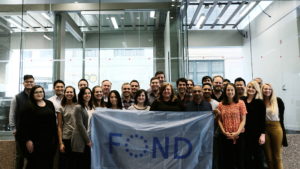
In the summer of 2017, I opted to move across the country to become a full-time remote contracted employee at my company. I went from working in an office nearly every day with wonderful people to being completely on my own and had limited interaction with my professional community.
I also felt an immediate culture shift and a lack of staff appreciation by becoming a contracted employee. It was during this eye-opening transition that I started to contemplate community and why it’s so vital in business. Here’s what I’ve been thinking about for the last year.

What in the world is community?
Is this where you live? Is it your family? Coworkers? The fellow parents you see in the car-rider line? The colleagues you grab lunch with a few times a week? The friends you occasionally interact with on social media but haven’t seen in years?
Why are any of these community members so important? When you find yourself in a new community, a less than ideal community, or no community, how do you adjust? How do you find or create community?
For me, these answers came in the form of a book club. Shortly after moving, I discovered the book Emotional Agility and wanted to read it to improve some things about myself. However, what I really needed was for others to hold me accountable to finish the book and have a meaningful conversation about it. In a brand new city, I created a Facebook group, scheduled the first meeting at my home, and then prayed people would show up.
Thankfully, this request for community resonated. With the first meeting, I knew I’d found my people: a solid group of women that had similar questions about life, community, elevating themselves, and growing professionally.
In the group, we had a business owner with a company in the education space nearing one million dollars in revenue, an attorney who owned her own legal practice, a finance professional, a marketing and social media manager, two project managers, a social worker, a large-firm corporate attorney, and an NFL nutritionist. I was astounded that this need for community resonated deeply across so many professions.
This got me thinking: if all of these professionals were also looking for community, could the same questions be asked of business too? What does community in the workplace mean? Are there pockets of communities within our organization that are not as cohesive as they could be? Most importantly, how can organizations create powerful communities that encourage loyalty, career longevity, and staff appreciation?
Creation, Maintenance, and Community Growth in the Workplace
Thankfully, because of my work as an enterprise account executive in the rewards and recognition space, I had daily access to live case studies for answers to these questions. Listening to how firms across industries created and maintained their culture became an obsession.
I realized that organizations with quality communities all leveraged a rewards and recognition platform to build their company cultures. Their platforms had the following in common:

1. A customizable approach to staff appreciation.
The most successful programs I’ve seen offer opportunities to recognize everyone in different ways. In a diverse organization, blue-collar workers can thank both their colleagues for safe practices on the job and their counterparts in the office.
Sales has the tools they need to stay engaged at headquarters and to interact with each other across multiple offices. Service anniversaries are celebrated along with birthdays, weddings, new additions to the family, graduations, or other life achievements.
Managers have access to funds for on-the-spot recognition, and executives give points to send organization-wide recognition for a quarter- or year- end. The opportunities for recognition are professional, personal, and span across teams and departments.
2. Analytics that provide insight into the company culture.
So you want to create or revamp a recognition program to better your organization’s community? Awesome. How do you do that without truly knowing where recognition is thriving and where it’s failing? Did your CFO schedule a last-minute meeting to understand the changes in culture and engagement since your new program launched? No problem.
A well-run program gives you access to this data at your fingertips (and preferably organizes it into a handy dashboard). The most successful programs have a partner that provides real-time analytics. Instantly accessible information provides valuable insight into what’s working for your program and where you can improve.
 3. An easy-to-use recognition platform.
3. An easy-to-use recognition platform.
There’s nothing worse than starting a new job and having 25 new programs to learn, and this is especially true for your recognition solution. If your solution isn’t intuitively integrated with Outlook, G-Suite, or any of your critical platforms, your employees have to disengage with work to engage with recognition.
The best solutions have the highest levels of buy-in because they are easy to use. Find a solution that integrates well with the technology your employees use every day. Additionally, find a solution with an intuitive interface that appeals to all technology user levels.
4. Buy-in from their executive teams.
Recognition is a top-down culture, every day of the week, every week of the year. The most successful programs are bolstered by executives regularly recognizing and rewarding employees. A Fortune 500 executive I spoke with recently disclosed that his company had sent one million eCards through their recognition platform.
He knew these stats not just because his own recognitions were part of them, but because they matter; the success of the staff appreciation program was paramount not just for creating, maintaining, and growing the community, but also for business. When you encourage your community to thrive, business does too.
Find the Right Solution

While my book club has exceeded my hopes for the community I craved, I spent the first two months in my new city floundering. Imagine if I’d been a brand new employee treading in a sea of change, desperate for the same.
A well-executed staff appreciation solution enables you to customize a wide variety of achievements, offers you transparent analytics, streamlines your processes so you can focus on more important tasks, and engages employees at all levels in your organization.
As your business grows and adds new hires — especially remote workers and employees relocating for their jobs — it’s imperative that you establish a culture that supports and elevates employees through these transitions. If new hires can’t establish themselves as a crucial part of your company culture and community, your best kept secrets may slip under the drowning waters of a murky culture.
 Sarah Payne is an Enterprise Account Executive at Fond with over five years of experience in launching, managing, and selling the world’s largest rewards and recognition programs. Sarah has a diverse background in oncology, the non-profit sector, and she’s even owned her own bakery. When she’s not collaborating to build the world’s best organizational cultures, Sarah loves to read, play the piano, travel, and spend time with her two greatest accomplishments, her daughters.
Sarah Payne is an Enterprise Account Executive at Fond with over five years of experience in launching, managing, and selling the world’s largest rewards and recognition programs. Sarah has a diverse background in oncology, the non-profit sector, and she’s even owned her own bakery. When she’s not collaborating to build the world’s best organizational cultures, Sarah loves to read, play the piano, travel, and spend time with her two greatest accomplishments, her daughters.
 3. An easy-to-use recognition platform.
3. An easy-to-use recognition platform.